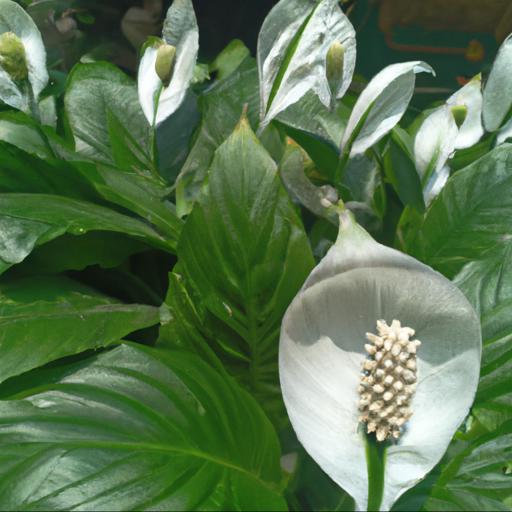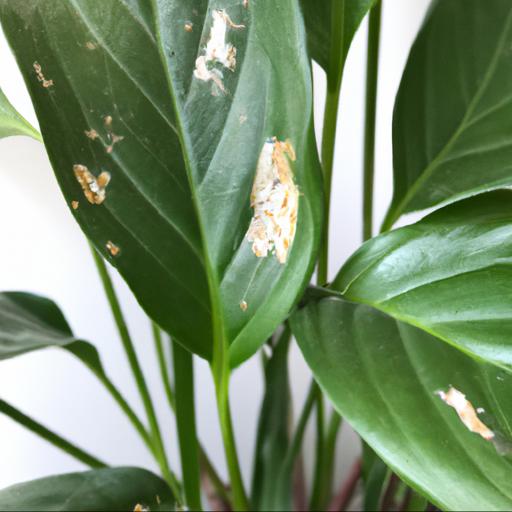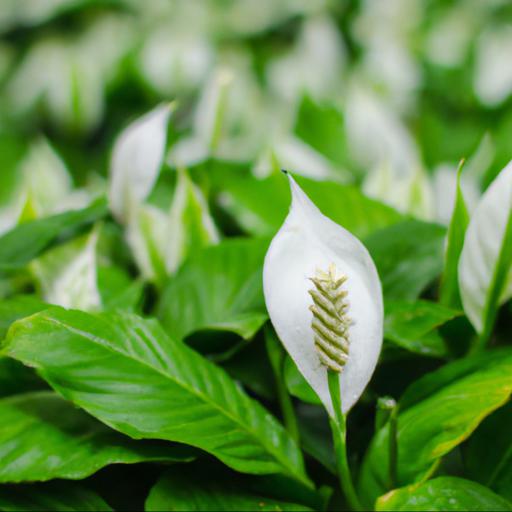Spathiphyllum wallisii, commonly known as the Peace Lily, is a popular and attractive houseplant that is native to tropical rainforests in South and Central America. It is a hardy, low-maintenance plant that is easy to grow indoors, making it a great choice for both novice and experienced gardeners. The Peace Lily is known for its glossy green leaves, white flowers, and its ability to clean the air of toxins.
It is also known for its ability to tolerate low light levels, making it perfect for rooms that don’t get much direct sunlight. With its beautiful foliage and air-purifying qualities, the Peace Lily is an ideal choice for any home or office.
Benefits of growing spathiphyllum wallisii

It’s not always easy to find a houseplant that’s easy to care for and that adds a bit of sophistication to your home. However, if these qualities are something you are after in your home, then look no further than the Spathiphyllum wallisii – an enduring houseplant that is sure to make a statement in any living space. Known more commonly as the peace lily, Spathiphyllum wallisii is one of the most popular houseplants known for its ease of care and air-purifying qualities.
It’s often used to liven up offices, decorate homes and apartments, or used as a gift. The beauty of the peace lily is that they are low maintenance and relatively easy to care for, making them a great choice for those who want some greenery in their home without it becoming too difficult to sustain.
In addition to the obvious environmental benefits of Spathiphyllum wallisii, there are other benefits that come with having this beautiful houseplant as part of your living space. The air-purifying qualities of the peace lily can help to remove formaldehyde, benzene and carbon monoxide from the air surrounding it. Not only does this improve air quality, but its flowers bring a sense of calmness and serenity to the room.
The peace lily is also known to absorb sound waves in a similar way to some types of acoustic insulation, reducing the overall noise level of the living space. The peace lily is certainly a great houseplant for any home but as with any houseplants, it must be cared for properly in order to get the most out of it.
Although it has low maintenance needs and is relatively easy to care for, the peace lily needs to be watered regularly and kept away from direct sunlight. Some peace lilies may also require higher humidity levels depending on the particular varieties.
If you can provide basic care to your peace lily and bring it a bit of luck, it will bring you some much needed peace and joy in the home.
Tips for growing spathiphyllum wallisii

Spathiphyllum wallisii, also known as the peace lily, is an easy-to-look-after houseplant. It is a popular choice among beginner gardeners due to its resilience and low-maintenance requirements. Taking care of a peace lily requires some knowledge of light and humidity levels, however, and with the right care, you can have a beautiful, thriving plant.
One of the most important things to keep in mind when caring for a Spathiphyllum wallisii is its light needs. Peace lilies like bright, indirect light.
For best results, place your plant in a spot that gets a few hours of natural, indirect light per day, such as a north-facing or east-facing room. In addition, it’s a good idea to rotate your peace lily every few weeks so that it gets light from all sides.
Another crucial element for successfully growing Spathiphyllum wallisii is maintaining the proper level of humidity. Peace lilies prefer to be kept in a spot that maintains a temperature around 65-75⁰F and has a relative humidity of 60-70%. To boost humidity around your plant, place a tray of pebbles and some water beneath your peace lily.
Make sure that the top of the pot is not sitting in the water, however, as this can cause root rot. Additionally, mist your peace lily regularly and use a humidifier in dry weather. Finally, proper watering is key.
Spathiphyllum wallisii likes its soil to stay damp, but not saturated. Water your peace lily when the top inch of soil is dry to the touch, and use room temperature water.
Avoid splashing water on the foliage, as this can cause spots. Once a month, flush the soil with lukewarm water to remove accumulated salts. With the right care and attention, your peace lily can be a source of beauty for weeks and months to come.
Common problems with spathiphyllum wallisii

Spathiphyllum wallisii, or the peace lily, is a popular houseplant for many reasons. It’s easy to take care of, grows in low light, and is beautiful when in bloom. But like any other plant, it isn’t immune to common issues.
As expert UK gardeners, we want to discuss the most common problems you may encounter with this common houseplant. The first issue to be aware of is overwatering.
Since this plant prefers damp soil, it can be common for gardeners to let the soil to become oversaturated. This leads to root rot, and eventually can kill the plant.
As such, it is important to water it sparingly and make sure to pour off any draining water. Another potential issue is acclimating it to sun if you move it outdoors. While it grows well in low light, it can start to suffer from sunburn if moved out into the sun too quickly.
Gradually move it out into the sunlight and allow it to adjust to the stronger light. Maybe the most common issue is simply failing to provide enough nutrients. While this plant is like a lot of houseplants, it still requires some nutrition, even if it isn’t being fertilized.
Adding in components like kelp or liquid fish fertilizer is an easy way to ensure the plant has enough nutrition to survive. Finally, pests or other diseases may occasionally appear.
Spider mites, mealybugs, and thrips are all potential issues, and it may be necessary to use an insecticidal soap or neem oil to eliminate them. Finally, it should be noted that sulphur dioxide, carbon monoxide, and even benzene can be toxic to the peace lily, so be aware of the air quality in any area you are growing the plant. As long as you are aware of the possible issues with your Spathiphyllum wallisii, you will be able to easily accommodate them and keep your peace lily thriving. It may take some additional research and effort, but you can easily maintain your peace lily without any major issues.
Final Touch
Spathiphyllum wallisii, commonly known as the Peace Lily, is an ornamental plant prized for its lush foliage and showy white flowers. It is an easy-to-care-for plant that is perfect for beginner gardeners. It thrives in warm, humid environments and requires indirect light and regular watering.
With its attractive leaves and flowers, the Peace Lily is an ideal choice for sprucing up any home or office.
FAQ
What are the ideal conditions for growing Spathiphyllum wallisii?
The ideal conditions for growing Spathiphyllum wallisii are bright, indirect light, high humidity, and well-draining, moist soil. It should be kept in temperatures between 65-80°F (18-27°C).
How often should Spathiphyllum wallisii be watered?
Spathiphyllum wallisii should be watered once a week, allowing the soil to dry out slightly between waterings.
What type of soil is best for Spathiphyllum wallisii?
Well-draining, slightly acidic potting soil is best for Spathiphyllum wallisii.
How much light does Spathiphyllum wallisii need?
Spathiphyllum wallisii needs bright, indirect light.
How can I tell if my Spathiphyllum wallisii is getting too much or too little water?
To tell if your Spathiphyllum wallisii is getting too much or too little water, look at the leaves. If the leaves are wilting or yellowing, it is likely getting too little water. If the leaves are drooping or the soil is soggy, it is likely getting too much water.
How can I encourage my Spathiphyllum wallisii to flower?
To encourage your Spathiphyllum wallisii to flower, you should provide it with plenty of bright, indirect sunlight, keep the soil moist but not soggy, and fertilize it regularly with a balanced fertilizer.

